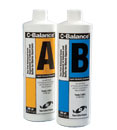|
We now know that virtually all corals, as well as coralline algae, require constant supplementation of calcium in order to thrive. As coral colonies and coralline algae grow and spread, the demand for calcium increases as they utilize and deplete more and more calcium. Calcium supplementation helps meet these biological demands by replenishing calcium levels in a closed reef system.
The concept of supplementing calcium in the reef aquarium was first described in the late 1980's, when the Berlin System for keeping corals was introduced to the public. This was a significant moment since little attention was paid to the coral's need for calcium for them to thrive and grow, prior to this series of articles.
Initially, the only method described was the use of calcium hydroxide
(Kalkwasser) dissolved in water to replace water that had evaporated. As reef aquariums became more sophisticated and stony corals and
clams became the dominant features in these systems, more sophisticated methods of maintaining calcium levels have developed. The methods that are currently being employed include: Kalkwasser, Kalkwasser and
carbon dioxide, Calcium chloride and buffer, balanced liquid or dry supplements, a
calcium reactor or a combination of these methods. |
 |









